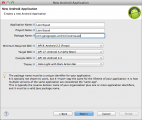Welcome to the “Laser Squad remake” development journal. I must say that this is the first time that I’m giving so much attention to a project of mine and share the whole development process publicly. I’m glad also that this project is actually a game, so I’m hoping that this journal will be also some kind of a tutorial how a game evolves from an idea to, hopefully, a finished product.
Before we start, I wanted to say something about what you can expect to read here. I’m developing this game completely in my free time and only then when I’m not spending time with my family. That leaves me a very small amount of hours for developing and even less time to keep track of everything in this journal. Don’t expect to read everything in detail how the game works; I’ll only cover the basics, share some of my thoughts during the development and provide as much screenshots as possible.
So let’s get things started…
The idea for a remake of Laser Squad for Android came by the end of September 2013. It’s been a while since I wrote my last game (Spacetracks) back in 2009; it’s definitely time to do some serious coding again. Since I wanted to start the project on October 1st, I used the mean time to think about the game mechanics and how realistic it is to finish at least that part by the end of the year. The other thing that bothered me was, should I use 2D canvas or 3D OpenGL rendering, even I knew the game will be definitely 2D; and if I go with 3D should I use version 1.1 or 2.0. It was a brainstormer, and even after when I’ve decided to use 3D, I’ve realized that actually it doesn’t really matter at this moment because the original game works with tiled graphics; meaning it could be represented also in plain text in a simple text view using the default Android monospace font. Suddenly, instead of state of the art graphics, I saw characters like “.” and “+” for the floors, and “O” for the walls… and of course, items on the ground will be temporarily represented with an “X”. What a relief, with this in mind I can set up the rendering basics really fast and concentrate on the mechanics of the game.






